For the last post in this impromptu series let’s look at my goal of somehow increasing the size of power supply capacitors within a unit connected to a Power Plant.
On the surface, this seems like a crazy goal. How can we affect something internally?
First, let’s think about what happens when we increase the power supply capacitance. A simple power supply consists of a diode bridge and a bank of capacitors. The diode bridge (rectifier) separates the incoming AC power in half. Let’s look at that.

The rectifier gives us separated positive voltage but there’s a problem. That voltage isn’t steady. Note all the peaks and valleys.
What we want is a straight line voltage. That’s called DC (like a battery). To make it DC we need to fill in the gaps between each 1/2 cycle. To do that we add capacitors which store energy. On the rising part of the wave, the capacitor is charged up like a small battery. On the falling part of the wave, the capacitor releases its stored energy and fills in the gap. It looks like this:

See what happens? It’s not a straight line but it is a rippled line. Almost straight. We refer to this as power supply ripple. Here’s a better picture.

The more capacitors we add the straighter that line gets and the closer to our ultimate goal of pure DC.
So knowing what we want and knowing we cannot physically add more capacitors, what can a Power Plant do?
We can extend the charging time, the point in the picture where the capacitor is charging. The longer that charging voltage stays high the more energy is added to the capacitor and the result is lower ripple.
Voila! Exactly the same result as it we were to add more capacitors and we did it externally.
That feature on a Power Plant is called MultiWave.






